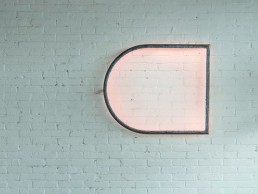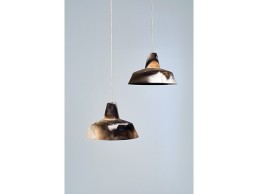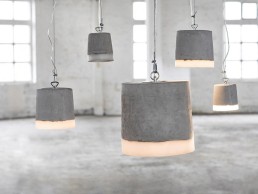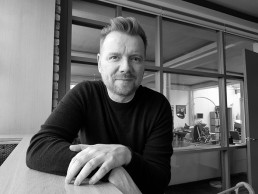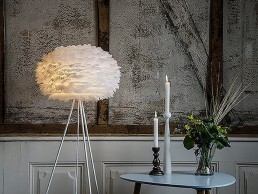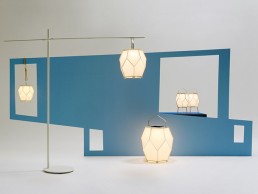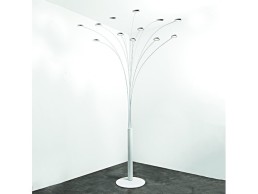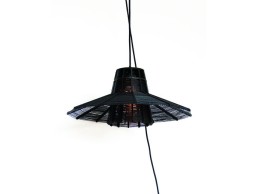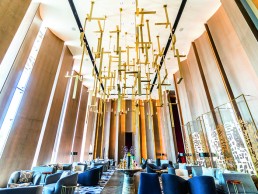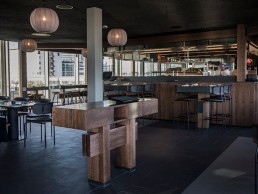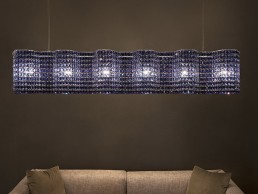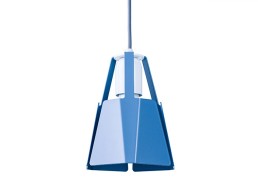Isaac Monte - Crystal
Belgian designer Isaac Monté has a fascination for unusual materials. His Crystal series is the result of research into stalagmites, one of the greatest wonders of nature. The objects are the result of the natural crystallisation of minerals and the influence of the designer on the formation process.
Studio Birgit Severin - Heimat
Studio Birgit Severin is known for its conceptual, aesthetic and material research driven design approach, finding inspiration in the arts and through exploring everyday experiences and activities. Their ceramic lampshade Heimat explores the analogy of memories and scorch marks by using traditional firing techniques.
Renate Vos - Concrete
Dutch designer Renate Vos's work is characterised by the use of materials and techniques. Her Concrete collection consists of various lamps developed out of a material experiment of concrete and silicone rubber. By using these materials, the lamps emit a warm light contradicting the series’ industrial appearance.
Seeing the Light
Tony Matters, Creative Director at design agency, Faber Design & Architecture, discusses the public’s evolving design consciousness, the power of well-executed lighting, and how he and his team are becoming increasingly involved in bespoke lighting design.
There has been a palpable shift in the design consciousness in recent years. The general public (and our clients) are becoming more design aware. They now place more importance than ever before, not just on what things look like, but on how well they function as a result of their design.
Long gone are the days when design teams could get away with rolling out a generic, aesthetically pleasing concept to simply smarten-up a space. Clients are now more discerning; they understand the importance of differentiating between local target markets – and can see the part design plays in that process. Eating and drinking out is such a competitive business that you can no longer just do an OK job. The industry is responding to this shift by choosing to invest more in restaurant and bar design. They’re stepping up to the plate.
Sculpting a space
It goes without saying that lighting is integral to any successful restaurant or bar project – but it also inspires great design. Our clients are often motivated to refurbish their bar or restaurant because of a lighting installation that’s captured their attention and imagination.
We’ve also learned over the years that lighting is one area of a project which can’t be compromised on. This is because light has a kind of power that no other element of design has. You could do almost nothing to a space, but if you light it well, it comes to life; it can be sculpted from a characterless box into something else altogether, adding warmth/drama/ambience/space, as needed. For me, light has two fundamental roles: one is functional and the other is emotional, and it’s that emotional component of lighting design I think is most powerful.
Form and Function
The challenge for many of our bar and restaurant clients is being able to create ambient, dramatic mood lighting, while still maintaining a workable space. This is where lighting design expertise really comes into its own – and a DIY restaurant refit is often betrayed by the absence of this key element. While most of our clients have a good understanding of the importance of lighting design, there is sometimes a danger they have only a superficial understanding of lighting strategy.
At Faber, we tend to look at light as a series of layers. We begin with a ‘base’ layer of background and concealed lighting, and then build on this with other layers of task and feature lighting, allowing us to carve out a space in a particular way.
A good example of this type of lighting strategy in action is Buffalo & Rye, a restaurant on Bennett’s Hill in Birmingham, and one of our recent projects. Here, we purposely created the darkest restaurant we could, but with deliberately placed lighting to make the space both functional and atmospheric. When you walk in, even in the middle of the day, it maintains this effect. Another example of how lighting has worked to sculpt and unite a disjointed space is in our design for No.26 Aston Marina; a rural, canal-side restaurant in Staffordshire, based in a large, featureless steel unit. Here, we selected a variety of characterful light installations to cultivate shape and personality, and to celebrate the history of the restaurant’s surroundings.
A New Light
Trends in interiors, like any other element of design, are often fleeting. But when it comes to refitting a bar or restaurant, the design needs to have a degree of longevity and durability; both to withstand the pummelling of thousands of customers, and to maintain its visual appeal and cultural relevance. Lighting is something that can – and should – be designed to last. If a restaurant is going to be commercially sustainable, it will inevitably need to evolve. But a well thought-out, effective lighting scheme can remain a constant, if it’s done in the right way.
Developments in lighting technology have now made exceptional lighting design accessible for all. LED technology has given us more to play with, whether that’s linear LED, concealed LED, or exposed filament bulbs. It used to be the case that if you wanted to cultivate a warm, classic glow with your lighting, you had to pay a fortune for halogen that would only last a couple of weeks. LED now allows us to mimic the ambience created by old-fashioned lighting methods, but in an efficient product.
Finding the right supplier, someone who understands your ethos and approach, and can work with your creative process, can be what makes or breaks a project. We like Astro, because we feel they have a similar ethos to us; British-design, built on elegant simplicity that speaks for itself. Just as lighting design itself should never be undervalued in a project, neither should the importance of a like-minded supplier.
Lighting The Way
We believe it’s important to understand how things are made, so that when we communicate our design to the manufacturer, we know we are building something that is sustainable and intelligently designed, rather than simply leaving it to the person making it to interpret our ideas. That, to us, is simply not good enough.
With this in mind, our relationship with light and lighting design has grown over the years and is evolving still. As a designer, I’ve always had a passion for making things and, alongside our project work, we are becoming increasingly involved in the design of bespoke light installations. This is something we have always done to a degree; using our in-house lighting expertise to create unique, stylised solutions to a client’s lighting conundrum. Sometimes it’s happened by accident, like when someone spotted a chandelier we designed for the lobby of our Leicester office and asked us to recreate it (but enlarged by a factor of ten) At other times, it has been what’s differentiated us from competing design agencies and has helped steer the direction of an entire design.
We are excited to see how this area of our business will develop. Lighting has always been so integral to what we do and will continue to inspire and shape the way we approach design for years to come.
Vita Copenhagan - Eos
The Eos light collection is inspired by the force and beauty of the earth tones of the Nordic landscape. It perfectly suits any interior design, adding a sophisticated and elegant touch with its timeless look. It comes in three different colours: light grey, white and light brown and five different sizes: mini, medium and large.
Maiori - Couture by Normal Studio
Making use of Maiori's solar technology but adding an innovative fabric, developed in partnership with Serge Ferrari, the Couture outdoor collection of lights are inspired by traditional Asian lanterns. Weather-resistant and light diffusing, the fixtures make use of a new luminescent fibre and are available in three sizes.
Icone Luce - Arbor
Arbor is a tribute to nature without any space for unnecessary elements. Arising from a bundle of linear elements, gathered to form a bouquet of stems for light flowers, very simple lines and circles radiate light. Available in both a pendant and ceiling light it is made of aluminium and cold-drawn iron.
Alvaro Diaz Hernandez - Knit
Knit is a pendant lamp from designer Alvaro Diaz Hernandez. Combining laser cut technology and handcrafted assembly it is a clever structure with a leather cord screen that covers the light giving a pleasant glow and making subtle shadows. Hernandez participated in the Design Stars showcase at IFFS.
The Four Seasons, Kuwait
The Four Seasons Kuwait is a game-changer in the hotel operator's portfolio thanks to sleek design from Yabu Pushelberg. Working with lighting consultants VISO, statement pieces adds to the hotel's immersive and memorable experience, as Helen Ankers discovers.
The Four Seasons Hotel Kuwait has been designed with sleek, avant-garde luxury and is the stylish new centrepiece of Kuwait City. Part of Burj Alshaya, a glittering new two-tower complex that is close to many business and leisure amenities, it is a focal point for the city’s elite social scene. With interior design from Yabu Pushelberg, this property is a game-change in the Four Seasons portfolio and has upped the ante in design terms, making the hotel experience completely immersive and perhaps most importantly, extremely memorable. “This particular hotel was designed with a guest in mind who is refined, well-travelled and culturally informed,” George Yabu of Yabu Pushelberg tells darc. “There is a distinct connection to ‛place’ within the design vocabulary of the hotel, and even though the context is from within the Middle East, visitors are transported beyond the boundaries of Kuwait.”
One of the first pieces of striking lighting guests encounter as they enter the hotel lobby is a Lasvit crystal installation. The largest crystal the Czech company has ever produced, the installation represents Yabu Pushelberg’s interpretation of what guests would normally expect to find in the lobby of a grand hotel, except more modern and utterly unique. “Our client initially asked us to make a grand statement in the hotel’s lobby and asked us for an oversized crystal chandelier,” explains Yabu. “We pared back this notion and designed the world’s largest crystal. We believe the impact is stronger and clearer, but just as special. The crystal’s multifaceted asymmetry is extremely compelling and reflects light and its surroundings in a beautiful way.
“The dramatic triple-height space in the lobby required something monumental, something elegant and bold that would leave a lasting impression. Soaring ceilings enhance the sculpture quality of the architecture, which is punctuated by the iconic suspended crystal sculptural installation.” The installation contributes to the overall welcome and residential quality of the hotel. Layered throughout, are subtle references to Middle Eastern art and architecture, detailed and re-interpreted in a modern way. Materials, a sense of texture, patterning and colours in particular, are all informed by the intensity of the desert and the local climate, playing with the contrast between daytime heat and cool nights.
In the guest rooms, the design is explicitly chic with every comfort carefully considered. Upon entry, guests follow a short millwork-lined corridor as the room unfolds beyond. Neutral furnishings are complimented by moments of bold colour, while curvilinear furnishings soften sculptural framed elements. Up-lit indigo glass, decorated with a dissolving motif, frames the area behind the bed and on the opposite wall, while burnt orange lacquer defines the entry niche, pantry and stationary wall. Patterning on sliding glass doors, leading to the generous bathrooms, mimic the glass panels behind the bed. Wrapped entirely in stone, with small mosaic tiles on the curved wall behind a freestanding tub, slabs of the same stone feature on the walls, floors and vanity top. The vanity has been designed as a furniture piece and includes the same bronze accents as the custom furniture in the guest room. Layered, framed mirrors with integrated lighting complete the bespoke look.
“Good lighting is integral to what we do,” says Yabu. “It always sets the mood and tone of a space. We try to work with the best in every aspect of our design and this includes bringing in the best lighting consultants to each project.” With this in mind, Yabu Pushelberg chose to work with VISO on the design-engineering and fabrication of the bespoke decorative lighting elements throughout the rest of the hotel. The task was to create luxurious, unique, yet timeless designs to support the interior elements and bring the story of the Four Seasons Kuwait alive. Utilising elements such as brass, glass and resin, VISO created stunning fixtures for the hotel, including the custom brass chandelier that hangs in the lobby lounge. Collaborating closely with the team at Yabu Pushelberg, they developed a design that balanced the aesthetic with the scale, while still communicating the story set forth in the brief.
One of the key decorative lighting considerations Yabu Pushelberg wanted to focus on was the communication of organic elements within the designs, as VISO's Tzetzy Naydenova explains: “While guests are indoors, the designers wanted them to enjoy a sense of calm and serenity that nature provides. They provided us with their ideas and inspirations in the form of sketches and images of the lighting in order to inspire our team and create the fixtures they envisioned. While some of the sketches were very specific and included measurements and material requirements, others only indicated the inspiration and design intent. This was all we needed to get started… We knew that Four Seasons and Yabu Pushelberg stood for the best of the best and our task was to create just that. “Once the fixtures were determined, the next task was to install them in a way that didn’t interfere with other elements in the space. A lot of balancing and calculations were involved, along with some sleepless nights! But we think the final result could not have been any better.”
VISO’s work can be found in the hotel’s restaurants, business lounge, ballrooms, meeting rooms, pool area, hallways and common areas. As well as the brass chandelier in the lobby, bespoke fixtures include custom ceiling installations on the ground floor and first floor; rectangular pendant clusters in the meeting rooms; four large dome pendants in the first floor lounge, a custom steel pendant lamp in the fourth floor dining area; a dandelion suspension lamp on the ground floor; geometric pendants in Elements restaurant; and glass and metal pendants in the pool and spa area. “The pool features dozens of glowing lanterns hanging above the pool itself,” says Yabu. “This is flanked by archways and alcoves, which create semi-private, intimate lounging areas for guests, all enveloped in a palette of deep indigo stone with dramatic veining and smooth and textured limestone. The oasis, grotto aspect of the space is both calming and inviting. Mysterious, mood lighting enhances this feeling in a restrained, ethereal way.” In terms of challenges with this project Naydenova tells darc: “The high ceilings at the Four Seasons Kuwait are one of the many stunning architectural details. They convey a sense of drama but also created a design-fabrication and installation challenge for us. We worked on developing fixtures that didn’t get lost in the space or overwhelm the interior design. Not only was the design a key component, but the engineering process to create structurally sound fixtures was just as important. “One of the bigger challenges our team faced was with the large brass chandelier in the lobby lounge. Due to its unique design and extremely large size, the design and engineering teams had to find the perfect balance that worked with the structure’s architecture. The structure is made from rectangular, L-shaped brass panels and features a handmade hairline bronze finish. If the L-shaped pieces were not put together exactly as per the mathematical calculations, it would have posed a structural risk to the fixture as a whole. For this reason, the specific size and placement of each L-shaped piece was calculated accordingly to find the precise joining / suspension point in order to achieve structural balance and symmetry in the space.” Another challenge for VISO was the large dome structures the team fabricated for the business centre of the hotel. “Yabu Pushelberg wanted to have four acoustical dome fixtures that can absorb noise over each meeting table,” says Naydenova. “This way, meetings conducted in the room could not be overheard and privacy retained. At the same time, the domes were specified to have a metal finish, be manufactured in one piece and to have indirect light emanating from them.” Meeting all of these requirements for one specific structure was a challenge for the VISO team, because metals don’t meet the acoustical requirements and such large domes need to be fabricated in two or more sections. According to Naydenova, there was no precedent for a light fixture like this before and her design and engineering team spent a large chunk of their time on R&D to find a solution. What they came up with was a carbon fiber dome that could be fabricated as one piece. This was followed with an application of a special acoustic resin to allow it to absorb sound. Next, the domes were finished with a unique paint that gave them the look of metal. Finally LEDs were installed inside the cove on top of the dome to provide a metallic glow and to illuminate the ceiling.
“There were so many design elements in this hotel and we appreciate we played just one of many roles in its development,” says Naydenova. “For us, lighting helps tell the story by translating the organic elements of the design as well as utilising luxurious materials and textures in both large and small scale. As discussed, the hotel had many large spaces for the lighting to fill and it was sometimes challenging for our team to envision the final result. The entire interior design just works beautifully and our fixtures are part of that! “I want to thank Yabu Pushelberg for choosing VISO as their decorative lighting partner on this project. The stand out feature for us, was to see our fixtures fit in with all the other lavish elements of the hotel. Working on this unique project has been an amazing experience; it challenged our team in many ways and it is because of these learning experiences that we continue to design and fabricate lighting fixtures.”
“Lighting has an enormous impact on the way a space is perceived and the way it feels,” concludes Yabu. “If lighting isn’t done well, everything else can falter. Lighting is seductive, the fine precision required to accomplish this is what is difficult to explain and difficult to achieve, but is entirely with the effort.
“Good design should transcend trends. We try to create environments that speak to hotel guests on a visceral level, we believe we have achieved this with the Four Seasons Kuwait.”
Sticks 'n' Sushi, Denmark
East meets West in OEO Studio's design for new flagship restaurant Sticks ‘n’ Sushi, Copenhagen.
Copenhagen-based OEO Studio has completed the design of a new flagship restaurant for Sticks ‘n’ Sushi. Located on the top floor of the new Tivoli Corner building in Copenhagen, overlooking the city’s historic Tivoli Gardens and skyline, Tivoli corner is a multi-functional development designed by renowned architects Pei Cobb Freed & Partners of New York. The newly built space is home to retail outlets, restaurants, a food hall and 21 new guestrooms for the Nimb Hotel.
Sticks ‘n’ Sushi approached OEO Studio in the summer of 2016, the studio worked on the project for a year and half, transforming the restaurant's Japanordic brand DNA into a unique and bespoke spatial experience. The design concept devised by OEO reflects the meeting of East and West and draws on inspiration from Japan reinterpreted into a modern European context. The result is a warm and welcoming space with many evocative details, bespoke design elements and high quality materials blended together to offer a taste of Japan in central Copenhagen. Early in the design process, OEO Studio was faced with a challenging rooftop restaurant and the complex architecture of the building itself. “The building is unusual in that there are no straight walls in the space and floor-to-ceiling windows on both sides,” OEO Studio Creative Director and Founder, Thomas Lykke tells darc. “We noticed that a birds-eye view of the building resembled the shape of a fish and chose to use this apparent outline as an abstract starting point for designing the restaurant space.” The design team employed deep, earthy ceramic tiles by Italian company Mutina on the floor of the restaurant to subtly represent the scales, fins and eye of the fish. The whimsical design detail would be impossible for the human eye to grasp while in the space without prior awareness of the designer's intent. Bespoke artwork has been introduced to elevate and enhance the diner’s experience, including a small group of handmade wire fish created by Danish designer Anders Hermansen. The fish gently guide diners from street level to the heart of the restaurant on the third floor.
The restaurant design comprises a mix of dining-height and high counter seating, offering a range of views to the open kitchen and out across the city skyline. A private dining room that can accommodate groups of up to 20 diners features a bespoke stained ash 6.4m long table designed by OEO Studio and warm wooden oak flooring. The space, when not in use for private dining, offers casual seating for smaller groupings along the table.
The designers at OEO paid careful attention to the acoustics of the space to balance the bustle of a busy restaurant with intimate dinner conversation. Innovative Rhomb panels in a dark anthracite shade by Troldtekt have been introduced to strengthen acoustics, resulting in an unobtrusive and discreet decorative look. Throughout the restaurant, OEO Studio has incorporated superior interior materials including high-quality ash and oak, Swedish Oland limestone, hot rolled steel and Italian ceramics. Large Pico tiles by Bouroullec for Mutina feature in the bathrooms along with bespoke wooden cabinets, natural stone wash-basins, black Dornbracht faucets and lighting by Danish design brand Frama.
The centrepiece and focal point for all of the action taking place in the heart of the restaurant is the kitchen structure and pavilion. The custom-built wooden structure provides a skeletal frame with built-in direct light as well as diffused light on order to enhance the overall dining experience. The surrounding decorative lighting takes inspiration from both Japanese lanterns and traditional Chinese rice lamps. A considered restaurant lighting programme is comprised of both mood and technical solutions, which blend perfectly to support the entire spatial experience. OEO Studio worked closely with the lighting brands and suppliers in order to optimise the sense of ambience, light sources and functionality. Soft mood lighting includes the use of transparent Knit-Wit Light by Iksos-Berlin for Made by Hand. The 360° 3D-knitted lamp design takes inspiration from the sun and the traditional Chinese rice lamp, symbolic of the Far East. Shy Berry-coloured perforated Satellite pendant lights by Mathieu Mategot highlight the bar area, while a magnetic LED spot solution from Deltalight creates a sense of theatre around the restaurant’s open kitchen.
“Lighting is essential in creating a welcoming atmosphere,” Lykke says. “Good lighting supports the dining experience no matter where you are seated in the restaurant, whether you want an intimate setting or wish to be seated more casually by the bar counter. No matter where you are in the restaurant you have great views overlooking Tivoli Garden or the city’s skyline.
“Despite the open space with floor to ceiling windows on both sides the result is a warm and welcoming space with many evocative details, bespoke design elements and high-quality materials that blend together to reflect the meeting of East and West. ”
Lolli e Memmoli celebrates 25 years
(Italy) - Lolli e Memmoli celebrated its anniversary in the spotlight at Salone del Mobile 2018 with a special retrospective guiding visitors through its 25-year journey.
The story of Lolli e Memmoli’s artistic workshop investigates all aspects of lighting design and defines a new way of handling light in a continuous reference between large traditional chandeliers and experimental design. Without any supporting backbone, crystal drops are set free in harmony revealing an extraordinary game of light multiplied by the infinite sparkle of crystal purity. These scenographic artworks of light were on display at the 25 anniversary exhibit, staged within the elegant spaces of Lolli e Memmoli’s showroom in Via Vivarini, Milan. Ugolino, Vladimiro, Caifa, Opus, Aires, Taut, U-Line and their many variants reveal a technical and stylistic deconstructivism making each design more and more ethereal: traditionally well-known forms disappear into an intangible experience of light. The exhibition culminated in a new design: Algebra, the modular light with a sinuous profile inspired by the etymology of its name.
Dreizehngrad - Beat
Three faceted metal wings embrace the light source and dispense light downwards and upwards. Minimalist and distinctive in design the pendant light sets exciting accents and applicable versatilely. The precise geometric form adapts to different interior styles and environments. Available in three colours.


